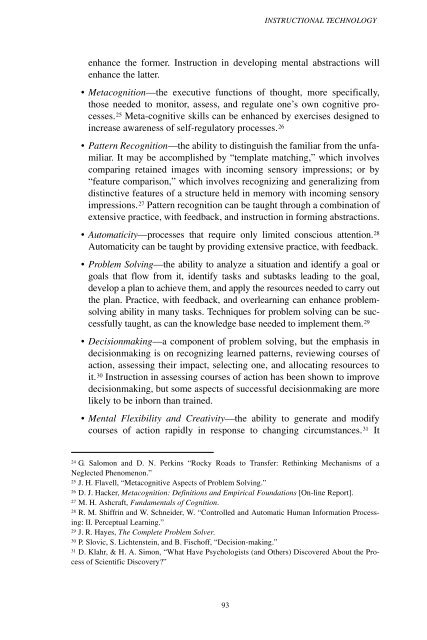Analytic Culture in the U.S. Intelligence Community (PDF) - CIA
Analytic Culture in the U.S. Intelligence Community (PDF) - CIA
Analytic Culture in the U.S. Intelligence Community (PDF) - CIA
Create successful ePaper yourself
Turn your PDF publications into a flip-book with our unique Google optimized e-Paper software.
INSTRUCTIONAL TECHNOLOGY<br />
enhance <strong>the</strong> former. Instruction <strong>in</strong> develop<strong>in</strong>g mental abstractions will<br />
enhance <strong>the</strong> latter.<br />
• Metacognition—<strong>the</strong> executive functions of thought, more specifically,<br />
those needed to monitor, assess, and regulate one’s own cognitive processes.<br />
25 Meta-cognitive skills can be enhanced by exercises designed to<br />
<strong>in</strong>crease awareness of self-regulatory processes. 26<br />
• Pattern Recognition—<strong>the</strong> ability to dist<strong>in</strong>guish <strong>the</strong> familiar from <strong>the</strong> unfamiliar.<br />
It may be accomplished by “template match<strong>in</strong>g,” which <strong>in</strong>volves<br />
compar<strong>in</strong>g reta<strong>in</strong>ed images with <strong>in</strong>com<strong>in</strong>g sensory impressions; or by<br />
“feature comparison,” which <strong>in</strong>volves recogniz<strong>in</strong>g and generaliz<strong>in</strong>g from<br />
dist<strong>in</strong>ctive features of a structure held <strong>in</strong> memory with <strong>in</strong>com<strong>in</strong>g sensory<br />
impressions. 27 Pattern recognition can be taught through a comb<strong>in</strong>ation of<br />
extensive practice, with feedback, and <strong>in</strong>struction <strong>in</strong> form<strong>in</strong>g abstractions.<br />
• Automaticity—processes that require only limited conscious attention. 28<br />
Automaticity can be taught by provid<strong>in</strong>g extensive practice, with feedback.<br />
• Problem Solv<strong>in</strong>g—<strong>the</strong> ability to analyze a situation and identify a goal or<br />
goals that flow from it, identify tasks and subtasks lead<strong>in</strong>g to <strong>the</strong> goal,<br />
develop a plan to achieve <strong>the</strong>m, and apply <strong>the</strong> resources needed to carry out<br />
<strong>the</strong> plan. Practice, with feedback, and overlearn<strong>in</strong>g can enhance problemsolv<strong>in</strong>g<br />
ability <strong>in</strong> many tasks. Techniques for problem solv<strong>in</strong>g can be successfully<br />
taught, as can <strong>the</strong> knowledge base needed to implement <strong>the</strong>m. 29<br />
• Decisionmak<strong>in</strong>g—a component of problem solv<strong>in</strong>g, but <strong>the</strong> emphasis <strong>in</strong><br />
decisionmak<strong>in</strong>g is on recogniz<strong>in</strong>g learned patterns, review<strong>in</strong>g courses of<br />
action, assess<strong>in</strong>g <strong>the</strong>ir impact, select<strong>in</strong>g one, and allocat<strong>in</strong>g resources to<br />
it. 30 Instruction <strong>in</strong> assess<strong>in</strong>g courses of action has been shown to improve<br />
decisionmak<strong>in</strong>g, but some aspects of successful decisionmak<strong>in</strong>g are more<br />
likely to be <strong>in</strong>born than tra<strong>in</strong>ed.<br />
• Mental Flexibility and Creativity—<strong>the</strong> ability to generate and modify<br />
courses of action rapidly <strong>in</strong> response to chang<strong>in</strong>g circumstances. 31 It<br />
24<br />
G. Salomon and D. N. Perk<strong>in</strong>s “Rocky Roads to Transfer: Reth<strong>in</strong>k<strong>in</strong>g Mechanisms of a<br />
Neglected Phenomenon.”<br />
25<br />
J. H. Flavell, “Metacognitive Aspects of Problem Solv<strong>in</strong>g.”<br />
26<br />
D. J. Hacker, Metacognition: Def<strong>in</strong>itions and Empirical Foundations [On-l<strong>in</strong>e Report].<br />
27<br />
M. H. Ashcraft, Fundamentals of Cognition.<br />
28<br />
R. M. Shiffr<strong>in</strong> and W. Schneider, W. “Controlled and Automatic Human Information Process<strong>in</strong>g:<br />
II. Perceptual Learn<strong>in</strong>g.”<br />
29<br />
J. R. Hayes, The Complete Problem Solver.<br />
30<br />
P. Slovic, S. Lichtenste<strong>in</strong>, and B. Fischoff, “Decision-mak<strong>in</strong>g.”<br />
31<br />
D. Klahr, & H. A. Simon, “What Have Psychologists (and O<strong>the</strong>rs) Discovered About <strong>the</strong> Process<br />
of Scientific Discovery?”<br />
93
















